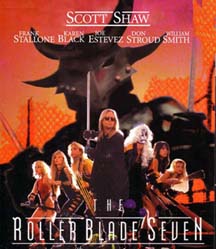The Roller Blade Seven
| The Roller Blade Seven | |
|---|---|
 The Roller Blade Seven Poster and Video Box | |
| Directed by | Donald G. Jackson |
| Written by | Donald G. Jackson Scott Shaw |
| Produced by | Donald G. Jackson Scott Shaw |
| Starring | Scott Shaw Karen Black Don Stroud Frank Stallone Joe Estevez William Smith Rhonda Shear Jill Kelly |
| Cinematography | Donald G. Jackson |
| Edited by | Scott Shaw |
| Music by | Scott Shaw |
Release date |
|
Running time | 90 min. |
| Country | United States |
| Language | English |
| Budget | $300,000 USD |
The Roller Blade Seven is a 1991 cult martial arts film directed by Donald G. Jackson and starring Scott Shaw.[1]
Plot and Style
The Roller Blade Seven unfolds in an abstract, dreamlike structure, utilizing minimal dialogue and repetition of footage in key scenes. Several sequences occur repeatedly, such as a scene in which the protagonist is seen to get on his motorcycle and ride out of a car-park eight times in a row, leaving from a different parking bay each time.
The film follows Hawk Goodman (Scott Shaw) who is sent on a mission by Father Donaldo (Donald G. Jackson) to rescue his sister, Sister Sparrow Goodman, from the clutches of the evil overlord Pharaoh (William Smith) in the apocalyptic world of the future. The film takes place in a region known as the Wheelzone whose populace travels solely by the means of roller skates or skateboards. Hawk, however, arrives riding a Harley Davidson motorcycle.
Sister Sparrow has been abducted from the Master of Light Institute by the evil Saint Offender (Joe Estevez). Before Hawk can complete his task, he must take psychedelic mushrooms with cult movie actress Karen Black and learn to rollerblade. Armed only with his samurai sword, Hawk does battle with the Black Knight (Frank Stallone), rollerblading ninjas and other gangs that inhabit the Wheelzone. Joining him on this mission are a Kabuki mime with a wiffle bat, a rollerblading banjo player entirely swathed in bandages and a pacifist named Stella Speed.
Pharoh's minions have been abducting women to make them his slaves. He explains that he uses a wheelchair due to an old skateboarding accident, and he longs for the days when he used to be able to ride a skateboard.
Distribution
This film experienced a short theatrical release in the United States, Australia, and Europe. It found a more willing audience, however, on Cable Television and in Video and DVD release.
Zen Filmmaking
Shaw and Jackson described the Roller Blade Seven as the first example of Zen filmmaking. This is a style of filmmaking in which no scripts are used.[2]
Sequels
The Roller Blade Seven was followed by its first sequel, The Legend of the Roller Blade Seven, in 1992 and a second, Return of the Roller Blade Seven, in 1993. There is also an alternate version of the film titled, Hawk: Warrior of the Wheelzone. In the documentary film Interview: The Documentary the two filmmakers, Donald G. Jackson and Scott Shaw discuss the process they followed in creating this film.
Reception
The film has a 1.9 out of 10 rating on Imdb and predominantly negative user reviews.[3]
The film was never “formally” released in the U.S., but has developed a cult following."[4]
References
- ^ Guide to American Cinema, 1965-1995, Daniel Curran ISBN 0-313-29666-9
- ^ Zen Filmmaking ISBN 1-877792-47-0 page 89
- ^ http://www.imdb.com/title/tt0102804/ IMDB article, accessed August 9, 2014
- ^ http://mishkanyc.com/bloglin/2009/09/30/roller-fiction-retrospective-pt-3-the-roller-blade-seven/ Roller Fiction Retrospective, Pt. 3, accessed February 29, 2012
